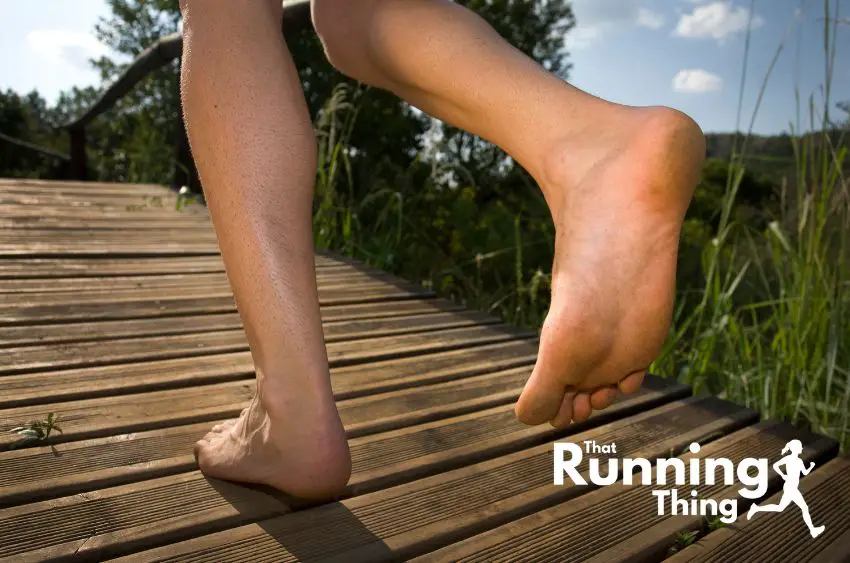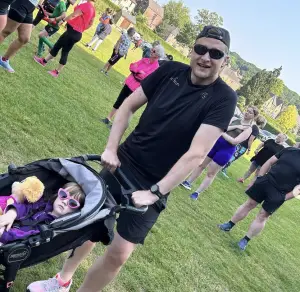Barefoot running has become a popular trend in recent years, with many runners ditching their traditional jogging shoes in favour of a minimalist shoes or no shoes. I like to wear shoes, just for the record, but I wanted to learn more about this topic.
One of the main benefits of barefoot running is that it encourages a more natural running technique. Running shoes with thick, cushioned soles can alter how the foot strikes the ground, leading to an unnatural gait that can increase the risk of injury.
Barefoot or minimalist shoes allow the foot to move more freely and encourage a midfoot or forefoot strike, reducing the impact on the joints and muscles.
Despite the potential benefits, barefoot running is not without its risks. Running without shoes can increase the risk of cuts, scrapes, and other injuries to the feet.
Additionally, runners used to wearing shoes may need to gradually transition to barefoot running to avoid overuse injuries. It is important for runners to carefully consider their goals and needs before deciding whether or not to try this.
Born to Run and the Start of the Barefoot Running Trend
In 2009, Christopher McDougall published his book “Born to Run,” which sparked the modern barefoot running trend. McDougall’s book follows the Tarahumara tribe in Mexico, known for their long-distance running abilities, and explores the idea that humans were born to run without shoes.
McDougall’s book argues that modern running shoes have caused more harm than good, leading to increased injuries and decreased overall foot strength. The idea of barefoot running is to allow your feet to move and function more naturally, as they were meant to.
Since the publication of “Born to Run,” many runners have switched to minimalist shoes or have started running completely barefoot.
It’s important to start slowly and gradually work up to running barefoot. This allows your feet to adapt and build up strength over time. Additionally, it’s important to pay attention to your running technique and ensure you’re not overstriding, heel striking or landing too hard on your feet.
Despite the risks, many runners have found success with barefoot running and have reported increased foot strength and decreased injuries.
For example, a runner who switched to minimalist shoes found that her chronic knee pain disappeared after months of running without traditional shoes. She also reported feeling more connected to the ground and more in tune with her body’s movements.
Benefits of Barefoot Running
Three Potential Benefits of Barefoot Running
This running style has been gaining popularity recently due to its potential benefits. While some risks are involved, barefoot runners mention several potential benefits that make it an attractive option for runners. Here are three of the potential benefits:
- Better balance and stability: it can help improve balance and stability by strengthening the muscles in the feet and ankles.
- Improved proprioception: Proprioception is the body’s ability to sense its position and movement in space. Running barefoot or a minimalist shoe can help improve proprioception by allowing the feet to feel the ground and adjust accordingly.
- Reduced impact: Running in traditional shoes can lead to a high impact on the joints, increasing the risk of injury. Running barefoot can help reduce this impact by allowing the feet to absorb some of the shocks.
What are the Benefits of Barefoot Running?
Aside from the potential benefits mentioned above, barefoot runners have several other benefits. These include:
- Improved foot strength and flexibility
- Reduced risk of blisters and other foot injuries
- Increased sensory feedback from the feet
- Improved running efficiency and speed
Is Running Barefoot Good for You?
While barefoot running can have several potential benefits, it’s not for everyone. Some people may be unable to run barefoot due to foot or ankle injuries, while others may simply prefer the comfort and support of traditional running shoes.
It’s important to listen to your body and consult with a healthcare professional before significantly changing your running routine.
One example of a barefoot runner is Zola Budd, a South African middle-distance and long-distance runner who competed in the 1984 and 1988 Olympic Games. Budd was known for running barefoot and setting several world records in the process.
Here is another great case study:
Drawbacks of Barefoot Running
Potential Drawbacks
One of the most significant risks of barefoot running is the lack of protection it provides for the feet. Without shoes, runners are more susceptible to cuts, bruises, and other injuries from sharp objects on the ground. Running on rough surfaces like concrete or gravel can also cause pain and discomfort.
Another potential drawback is the strain that can be placed on the muscles and joints of the feet and legs. Runners not used to barefoot running may experience soreness, foot pain, stiffness, or even injury as they adapt to the new running style. Additionally, barefoot running can put more stress on the Achilles tendon and calf muscles, leading to strain or injury.
Shoeless Risks
Running without shoes can also increase the risk of developing plantar fasciitis, a painful condition that affects the tissue connecting the heel bone to the toes. This condition can be caused by overuse or strain on the feet, which is more likely to occur when running barefoot.
Furthermore, running without shoes can increase the risk of developing blisters and calluses on the feet. These conditions can be uncomfortable and may interfere with a runner’s ability to train and compete at their best.
Finally, running without shoes can also lead to poor hygiene, as the feet are more exposed to dirt, bacteria, and other harmful substances. This can increase the risk of developing infections or other foot-related problems.
Despite these potential drawbacks, some runners may still choose to run barefoot or in minimalist shoes. It is important to weigh the benefits and risks and make an informed decision based on personal preferences and goals.
Are minimalist shoes good for flat feet?
Minimalist shoes can be good for people with flat feet, but it depends on the individual and their specific needs. Flat feet, also known as fallen arches, occur when the arches of the feet collapse, causing the entire foot to touch the ground. This can result in overpronation, which can cause foot pain, ankle pain, and even knee and hip pain over time.
These types of shoes are designed to be lightweight and flexible, allowing the foot to move more naturally and providing a barefoot-like experience.
However, choosing shoes that provide adequate support and cushioning, particularly in the arch and heel areas, is important to help prevent overpronation and reduce the risk of injury.
Example
For example, a runner who wants to improve their running form and reduce the risk of injury may choose to incorporate barefoot running into their training regimen gradually, starting with short distances and gradually increasing the intensity and duration of their barefoot runs.
Barefoot Running Shoes
Barefoot running shoes are designed to mimic the feeling of running barefoot while still providing some protection and support for the feet. A barefoot shoe is typically lightweight and flexible, with thin soles that allow for a natural stride and good ground feel. They often have wider toe boxes to allow the toes to splay and move as they would when running barefoot.
Those shoes for barefoot running are not meant to be a replacement for traditional running shoes, but rather a supplement for those who want to experience the benefits of it without the risks of going completely barefoot. They can help strengthen the feet, but they may not be suitable for everyone.
Barefoot Shoes vs. Traditional Running Shoes
Barefoot running shoes differ from traditional running shoes in a few key ways. Traditional shoes typically have thicker soles and more cushioning to provide shock absorption and support for the feet. They may also have features like arch support and heel counters to help stabilize the foot.
They allow the feet to move more naturally and encourage a forefoot or midfoot strike, rather than a heel strike. Barefoot shoes also tend to have wider toe boxes and less structure overall, allowing the feet to move and flex as they would when running barefoot.
Check out this video on running techniques:
While traditional running shoes may be better for those with certain foot conditions or injuries, barefoot shoes can be a good choice for those who want to improve their running form and strengthen their feet.
Conclusion
The debate about barefoot running continues, with proponents and sceptics on both sides. While there are potential benefits to running without shoes, such as improved foot strength and balance, there are also risks, such as the increased risk of injury and exposure to harmful bacteria and sharp objects.
It is important for runners to carefully consider their individual needs and goals before deciding whether to try barefoot running. If they do choose to do so, they should take the time to gradually build up their foot strength and be mindful of their environment.
A variety of minimalist shoe options can provide some of the benefits of barefoot running while still offering some protection and support. Runrepeat recently voted the Zero Shoes Zelon as the best minimalist shoes, check them out on Amazon if you’re interested.
Ultimately, the decision to run barefoot or with shoes is a personal one that depends on individual preferences and circumstances. Runners should carefully weigh the benefits and risks and make an informed decision that is right for them.
There are a number of barefoot running community support pages on Facebook or the internet:
Barefoot Running Society
Barefoot Runners
I hope this article has been useful; best of luck with your barefoot journey!


